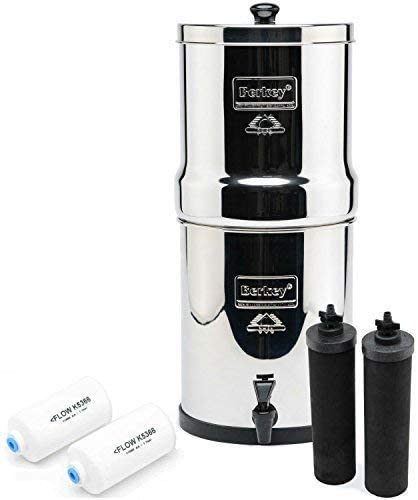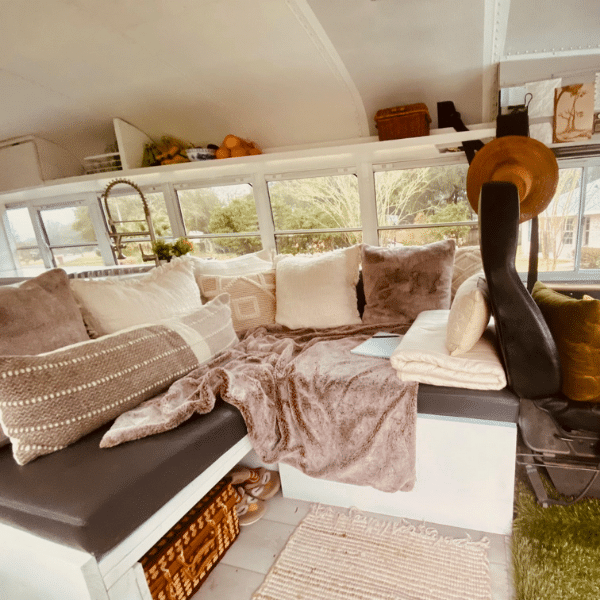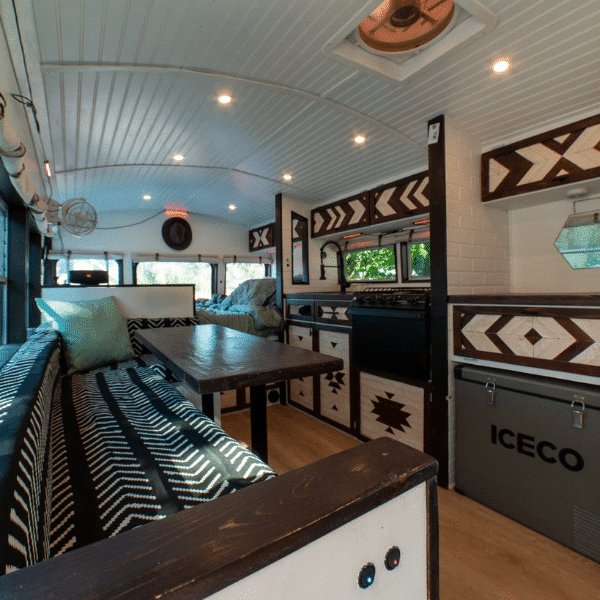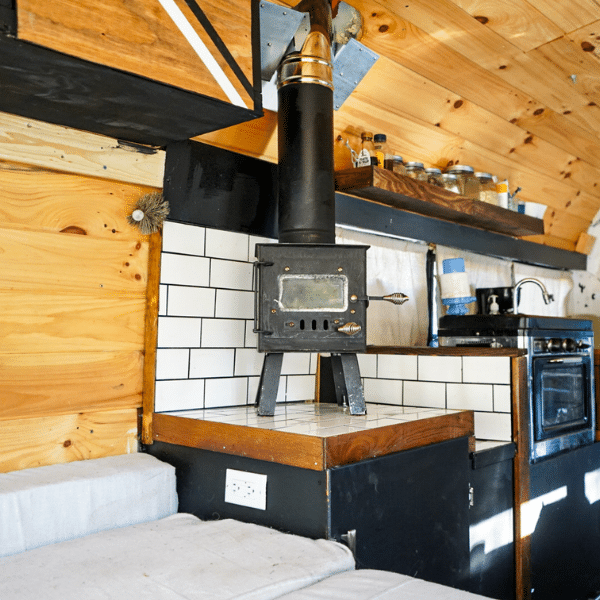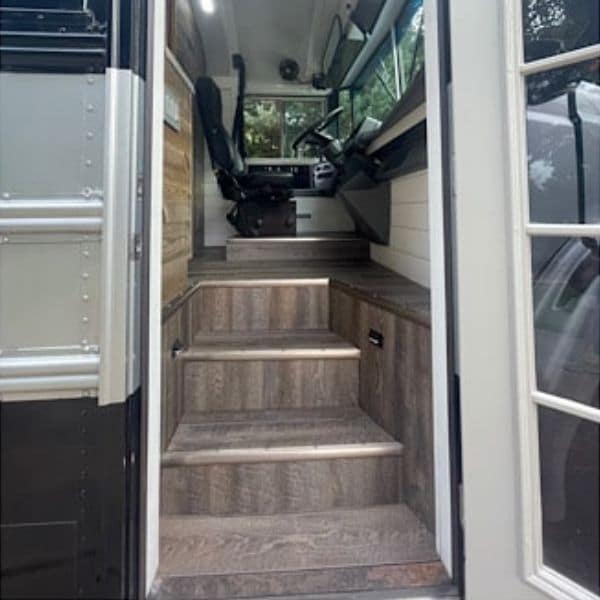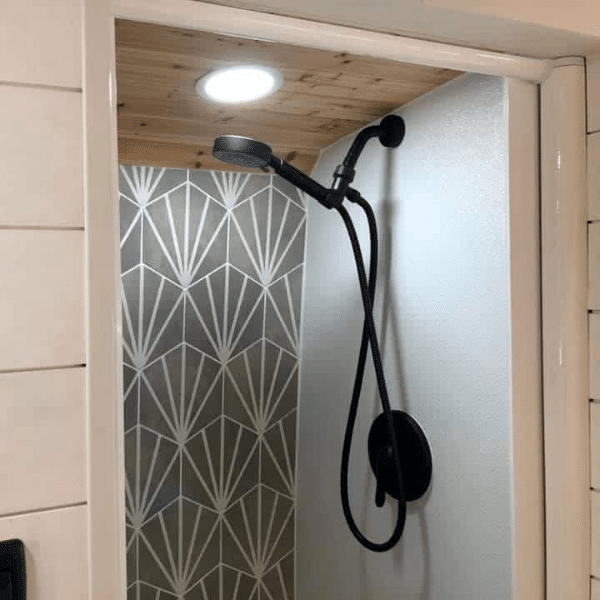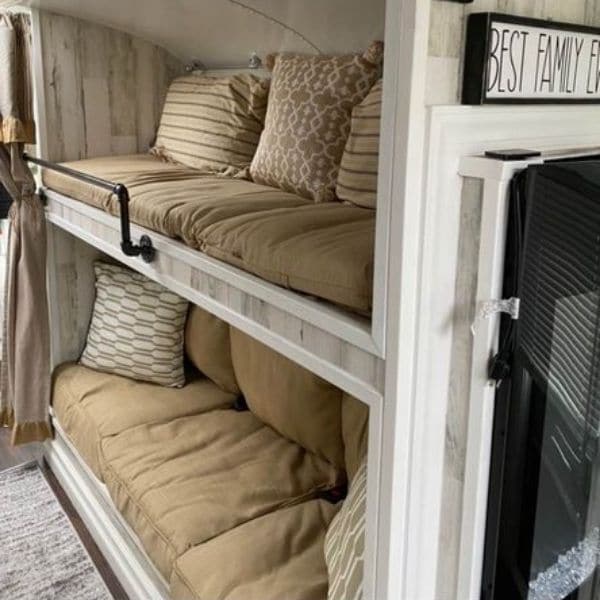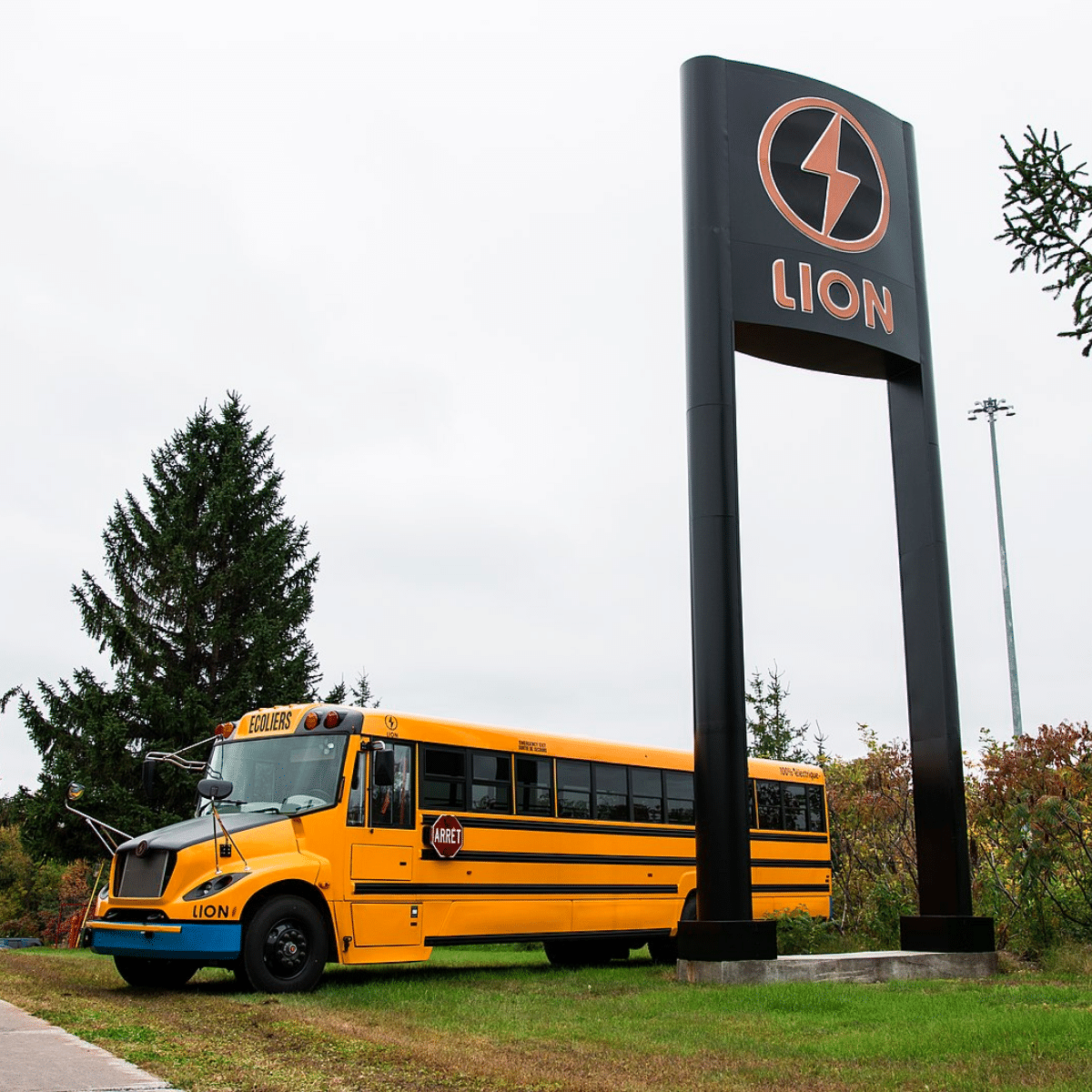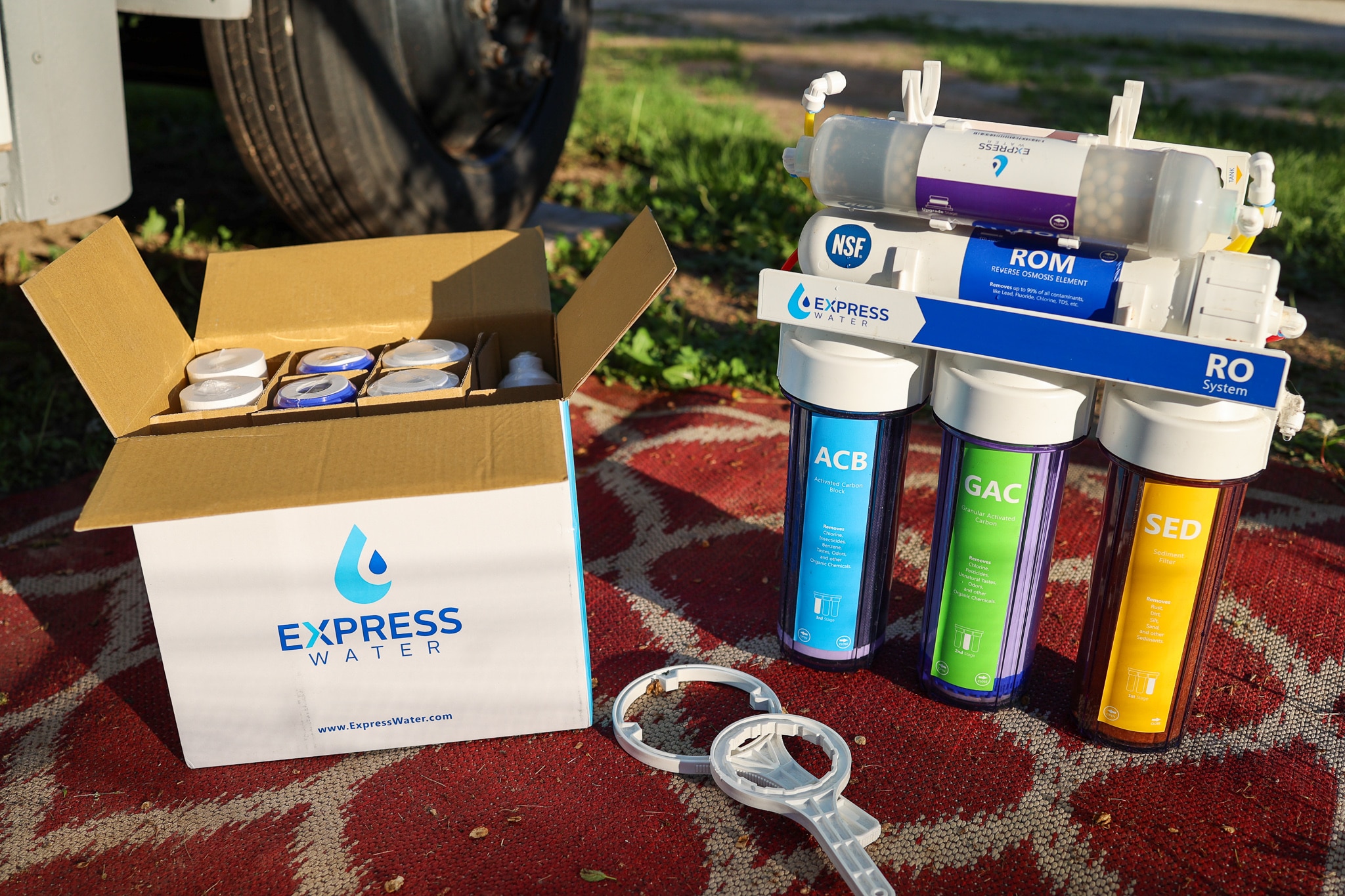
There are different skoolie water filter options that are best for specific scenarios, from the number of people living in your skoolie to the amount of countertop space and even the amount of refrigerator space you have in your skoolie.
We will go through the following options:
- Incoming Water Filter Systems
- Reverse Osmosis Systems
- Countertop Filter Systems
- Water Filter Pitcher Systems
For each option, we will review the pros and cons, when to use the water filters, how to install these water systems, and good product options for each category based on our extensive research on this topic.
Special Note: This article does have affiliate links. If you click a link and happen to make a purchase, we may receive a small commission at no cost to you. Thanks for your support – this commission helps us to continue serving the skoolie community!
Why Is Skoolie Water Filtration Important?

Did you know there are over 26 water-related illnesses? Water is so important for us to consume and it’s even more important that we are getting clean water or else we could contract some of these diseases.
You have most likely heard of the Flint, Michigan water outbreak. But have you heard of the Milwaukee, Wisconsin outbreak? Back in the 90s, there was a cryptosporidium outbreak which is a severe respiratory and gastrointestinal illness. It sent over 400,000 people to the hospital.
In 2014, I went to school in Milwaukee and my dad had told me numerous times to not drink the water and to always use a water filter because of the cryptosporidium outbreak that happened almost two decades ago. Yes, people still aren’t confident in the water here, even though they have spent millions on water treatment.
When we were converting our skoolie, we thought where would we be getting our water? The answer was we didn’t know. So we knew we wanted to invest in a good water filtration system for our skoolie so we had clean drinking water wherever we were.
I did some research on the types of contaminants and the health risks they may cause. From this research, I also included the type of filter we can have in our skoolies to eliminate them from the water we use and consume on the road.
| Contaminants | Health Risks | How to Filter |
| Aluminum | May cause adverse effects to the nervous system. Should be avoided for those with sensitive kidneys or kidney diseases. | Reverse Osmosis (RO) |
| Arsenic | Can cause serious skin issues, skin cancer, bladder cancer, lung cancer, kidney cancer, liver cancer, prostate cancer, and harms the cardiovascular & nervous systems. | Reverse Osmosis (RO) |
| Bacteria | 1-10 microns* in length 0.2 – 1 microns* in width | Ultraviolet (UV) |
| Barium | Most barium is not water soluble, but barium found in water can cause breathing issues, an increase in blood pressure, heart rhythm changes, irritation to the stomach, brain swelling, and muscle fatigue or weakness. Barium can also damage the liver, kidney, heart, and spleen. | Reverse Osmosis (RO) |
| Cadmium | Can cause damage to the kidney. | Reverse Osmosis (RO) |
| Chloramine | Can cause hemolytic anemia. | Activated Carbon |
| Chromium | Can cause nausea, gastrointestinal issues, stomach ulcers, skin ulcers, kidney and liver damage, reproductive problems, lung and nasal cancer, and allergic reactions. | Reverse Osmosis (RO) |
| Copper | Can cause symptoms of nausea, vomiting, diarrhea, gastrointestinal illness, abdominal and muscle pain. Severe cases can lead to anemia, liver poisoning, and kidney failure. | Reverse Osmosis (RO) |
| Cysts | 2 – 50 microns* | Ultraviolet (UV) |
| Fluoride | Can cause skeletal fluorosis, which is a bone disease used by excessive amounts of fluoride which leads to painful bone and joint damage. Children can also develop tooth discoloration and decay. | Reverse Osmosis (RO) |
| Lead | Can cause brain, bone marrow damage, kidney, nervous system, and red blood cell damage. Can also cause reduced intelligence, impaired hearing, and decreased growth in children. Children are at higher risk than adults. | Reverse Osmosis (RO) |
| Nitrates & Nitrites | Infants are most at risk to develop side effects, including blue baby syndrome (methemoglobinemia). | Reverse Osmosis (RO) |
| Mercury | High levels can impact brain function and increase irritability. Can cause changes in hearing, vision, and memory. May damage the kidney and a developing fetus in pregnant women. | Reverse Osmosis (RO) and/or Carbon Filters (GAC/ACB) |
| Radium | Increase risk of developing cancer. | Reverse Osmosis (RO) |
| Selenium | Causes hair and fingernail changes, increased fatigue and irritability, and damage to the nervous system. | Reverse Osmosis (RO) |
| Silver | Can cause skin discoloration. | Reverse Osmosis (RO) |
| Uranium | Causes kidney damage and increases the risk of cancer. | Reverse Osmosis (RO) |
| Viruses | 0.004 – 0.1 microns* | Ultraviolet (UV) |
Different Types of Skoolie Water Filtration
Before we jump in, let’s go over the different types of water filtration systems for skoolies.
You can filter the water before it goes to the fresh water tank or in your lines or you can filter your drinking water only. Of course, you can do both which is the best. That way, you can keep your fresh water tank a bit cleaner! Chris & I filter both ways to get the bigger contaminants out before hitting our freshwater tank. This makes it safer for us to use our “tap” water to brush our teeth. It also takes less strain on our reverse osmosis water filter system by filtering out the larger contaminants before it even touches the RO system. So we can get a longer life from the RO filters.
Filtering Incoming Water
Have you ever seen someone filling up their freshwater tank at a campground and seen that little filter attached to the hose before the water goes into their RV? That is what I am talking about when I say filter the water before it hits your freshwater tank. These types of filters are usually carbon or sediment filters, which filter out chlorine, bacteria, smell from water, and anything else that’s larger than ~20 microns.
Filtering Drinking Water Options
Getting an inline water filtration system, as mentioned above, may filter it enough for drinking water. But if you’re anything like me, you may want cleaner water than a sediment filter can give. Let’s get into drinking water filtration systems.
Reverse Osmosis Systems
One of the best ways to filter your drinking water is through a reverse osmosis system. These types of systems take out over 100 contaminants out of the water and add back in some essential nutrients. Some of the common reverse osmosis water systems are Express Water, iSpring, and Waterdrop.
Countertop Filter Systems
A countertop water filtration system is a system that sits on your countertop and you can add tap water to it and it will filter it. You can get clean drinking water from the spigot on the bottom after it’s filtered. A popular countertop skoolie water filters are Berkey water filter.
Water Filter Pitcher Systems
These types of water filtration systems are almost just like countertop filter systems, but these are small enough where they can be stored in your refrigerator so you have cold water. The popular water filters in this category are ZeroWater and Brita.
Let’s jump deeper into all of these!
Types of Filters and What They Filter Out
| Filter | What It Filters |
| Sediment Filter (SED) | rust, sand, dirt, and dust |
| Granular Activated Carbon (GAC) | chlorine, pesticides, bad tastes, and odors |
| Activated Carbon Block (ACB) | chlorine, insecticides, benzene, bad tastes, and odors |
| Reverse Osmosis Membrane (ROM) | fluoride, chromium, lead, arsenic, TDS, and radium |
| Alkaline Filter (ALK) | adds 5 stages of mineralization, antioxidants, and oxygen |
| Ultraviolet Filtration (UVS) | filters water through UV light |
| Post Activated Carbon Filter (PAC) | last pass that removes any bad taste or odor |
Skoolie Incoming Water Filter Systems
Incoming RV water filters are great at getting rid of the bigger contaminants and leaving your fresh water tank and plumbing lines cleaner. As skoolie owners, you never know where you will be able to fill up your tank with water. So you will at the very minimum want an inline water filter system so you can filter out those bad contaminants.
Pros & Cons of Incoming Filter Systems
As with anything, there are pros and cons for these incoming water filters.
Some pros are:
- Cleaner water tank
- Cleaner fresh water plumbing lines
- Safer for brushing teeth
- Gets rid of bigger contaminants
Some cons are:
- Doesn’t filter all of the contaminants out
- Doesn’t add back any minerals to the water
When to Use an Incoming Filter Systems
You will want to use an incoming water filter whenever possible. When traveling, you never really know where you are going to get your water, so to be sure you are filtering out those heavy metals, use a filter like this whenever possible.
Installing an Incoming Filter System
This is as simple as buying an inline water filter, screwing it onto the fresh water hose, and hooking it up to your tank when filling. Right when you receive it, you will want to make sure to let the water run for about 5 minutes to get rid of the carbon dust. Depending on how you have your plumbing set up, you can either let the filter run outside or at your kitchen sink.
Best Skoolie Incoming Water Filter Systems
Includes
- Sediment Filter (SED)
Does Not Include
- Granular Activated Carbon (GAC)
- Activated Carbon Block (ACB)
- Reverse Osmosis Membrane (ROM)
- Alkaline Filter (ALK)
- Ultraviolet Filtration (UVS)
- Post Activated Carbon Filter (PAC)
Includes
- Sediment Filter (SED)
- Activated Carbon Block (ACB)
Does Not Include
- Granular Activated Carbon (GAC)
- Reverse Osmosis Membrane (ROM)
- Alkaline Filter (ALK)
- Ultraviolet Filtration (UVS)
- Post Activated Carbon Filter (PAC)
Reverse Osmosis Systems

Reverse Osmosis, or RO, systems are a type of water filtration system that removes the contaminants in water by having the water go through a semipermeable membrane. It captures the dirty water and filters it out.
RO systems actually make water a bit more acidic by themselves. That’s why it’s important to add back in good minerals like calcium, potassium, and magnesium. RO systems by Express Water and iSpring already have the alkalinization part of the system. However, Waterdrop does not have any RO systems that alkalinize the water.
Pros & Cons of Reverse Osmosis Systems
As with anything, there are plenty of pros as well as cons for these RO systems.
Some pros are:
- It’s one of the cleanest filters you can get
- There’s a tank, so you will always have clean drinking water
- Filters out over 100 contaminants
Some cons are:
- Wastes a lot of water
When to Use a Reverse Osmosis System
Reverse osmosis systems come with a holding tank. The system will work to keep it full, refilling once it hits about 50% capacity. With that being said, you can use the RO water whenever you want and for whatever you want. Since it comes with its own separate faucet, I sometimes will use that water to brush my teeth.
Installing a Reverse Osmosis System
Installing a RO water filter system is pretty easy. We got the 11 Stage Express Water RO System and it came 75% setup. We just had to attach fresh water to it, attach the tubing between the filters, and discard the bad water.
One thing to note about RO systems:
Reverse osmosis systems are notorious for wasting water, meaning it can take 2 gallons or even up to 5 gallons to produce 1 gallon of RO water. Living in a skoolie and using an RO system means your grey water tank will fill up very, very fast.
We had our grey water tank fill up in one day before. It backed up into our shower and a backed up grey water tank is something you do not want to experience. Trust us. But we have found a solution to this…
Instead of running the “dirty” water to the grey water tank, we ran it to our fresh water tank. Yes, it’s the “dirty water,” but we fill our fresh water tank about every week or so, so the dirty water gets diluted into our fresh water.
5 Stage Reverse Osmosis Systems
Includes
- Sediment Filter (SED)
- Granular Activated Carbon (GAC)
- Activated Carbon Block (ACB)
- Reverse Osmosis Membrane (ROM)
- Post Activated Carbon Filter (PAC)
Does Not Include
- Alkaline Filter (ALK)
- Ultraviolet Filtration (UVS)
Includes
- Sediment Filter (SED)
- Granular Activated Carbon (GAC)
- Activated Carbon Block (ACB)
- Reverse Osmosis Membrane (ROM)
- Alkaline Filter (ALK)
- Ultraviolet Filtration (UVS)
- Post Activated Carbon Filter (PAC)
Does Not Include
N/A
Countertop Filter Systems
Countertop water filter systems can be a good option for skoolie owners, you just need to have enough counter space for these types of filters. Make sure to have a designated spot for this type of filter for traveling days, so it doesn’t tip over or crack.
Pros & Cons of Countertop Filter Systems
As with anything, there are plenty of pros as well as cons for these countertop filtration systems.
Some pros are:
- One filter gets 3,000 gallons of water before it needs changing
- Filters out over 200 contaminants
Some cons are:
- Takes up a lot of space
When to Use a Countertop Filter System
Fill up a countertop filtration system whenever you need fresh water. Since these types of filters use all of the water put into it (unlike the RO system), it may take a little bit for the water to go through the filters. Because of this, you may want to filter water in the morning or even at night so you have clean fresh drinking water all day long!
Installing a Countertop Filter System
There isn’t much to installing one of these besides making sure you get the filters in the right spot and they are tight. You’ll also want to make sure you have a dedicated spot for these on top of your counter as they are larger units.
Countertop Filtration System Option
Berkey Filter
Includes
- Sediment Filter (SED)
- Granular Activated Carbon (GAC)
Does Not Include
- Activated Carbon Block (ACB)
- Reverse Osmosis Membrane (ROM)
- Alkaline Filter (ALK)
- Ultraviolet Filtration (UVS)
- Post Activated Carbon Filter (PAC)
Water Filter Pitcher Systems
Water filter pitcher systems are the most basic water filtration system. We recommend going with a RO system as that’s where you will get the cleanest water. But we understand that’s an investment so here are some of the better water filtration pitchers.
Pros & Cons of Water Filter Pitcher Systems
These water filter pitcher systems are pretty basic water systems, so there are only a few pros and cons here.
Some pros are:
- Convenient
Some cons are:
- Takes up fridge space
- Filters can get expensive
- Only includes basic filtration components
When to Use a Water Filter Pitcher System
You will use this type of filtration system just as you would a countertop filtration system.
Installing a Water Filter Pitcher System
All you need to do here is to make sure the filter is in tightly so all of the water will go through the pitcher, not around.
Includes
- Sediment Filter (SED)
- Granular Activated Carbon (GAC)
- Activated Carbon Block (ACB)
Does Not Include
- Reverse Osmosis Membrane (ROM)
- Alkaline Filter (ALK)
- Ultraviolet Filtration (UVS)
- Post Activated Carbon Filter (PAC)
Includes
- Sediment Filter (SED)
- Activated Carbon Block (ACB)
Does Not Include
- Granular Activated Carbon (GAC)
- Reverse Osmosis Membrane (ROM)
- Alkaline Filter (ALK)
- Ultraviolet Filtration (UVS)
- Post Activated Carbon Filter (PAC)
*This article may contain affiliate links, which means we may receive a commission if you click a link and purchase something we have recommended. Please check our full disclosure policy for more details. Thanks for checking out our website and for your support!




